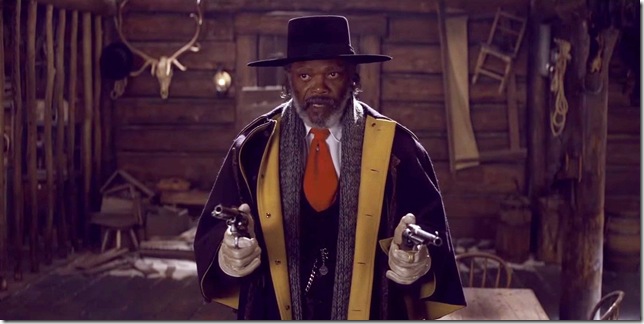Quentin Tarantino’s The Hateful Eight begins with a lengthy overture. We know this because the word “Overture” fills the screen in black 1950s-movie typeface, over a mountain landscape tinted the gaudy red of an Italian giallo. The film is then divided into six chapters, each functioning like a movement in a composition, and a 12-minute intermission divides the experience neatly in half.
All of which suggests Tarantino is thinking symphonically with his eighth feature, but if that’s the case, his song remains the same. Three years after Django Unchained, he’s still enraptured by the mythical romance of the bounty hunter and the lawlessness and racism of Civil War-era America — resulting in another provocative screenplay whose N-words are sprinkled like so much Parmesan cheese over this neo-spaghetti Western.
Mostly, though, it’s a movie about movies. This self-reflexivity arguably is the overriding constant in Tarantino’s work, only this time the movieness is so hermetically distilled that its target audience is the director’s smallest niche yet: cinephiles specializing in a certain brand of 1970s exploitation film.
Indeed, The Hateful Eight may open on a thousand screens over the next couple of weeks, but it’s the kind of film that, 40 years ago, would only have screened in the seedy theaters, downtown, late at night, on scratched-up prints. Throwbacks to the cinema of yesteryear color the film’s fetishistic texture, including the credits, the Ennio Morricone score (which partially recycles samples from his Exorcist III and The Thing scores), and the plot, such as one exists.
If Django Unchained took inspiration from Sergio Carbucci’s original Django, Tarantino’s reference points this time around appear to include John Ford’s Stagecoach, particularly the idea of strangers forced to share the cramped confines of a dangerous vehicle. The Hateful Eight is set during a Wyoming blizzard shortly after the Civil War, and the only coach still running in the frightful weather is paid for by John Ruth (Kurt Russell), a bounty hunter handcuffed to his $10,000 prize — alleged murderer Daisy Domergue (Jennifer Jason Leigh).
Soon enough, he picks up another bounty hunter, Marquis Warren (Samuel L. Jackson), a disgraced former Union general stranded in the snow with three of his bodies to deliver to the authorities. Then a third visitor joins this uneasy cab of killers: Chris Mannix (Walton Goggins), a rebel soldier who claims to be the new sheriff of Red Rock.
The vehicle stops at the only hotel along the way, a rustic cabin whose owners are mysteriously missing, with a Mexican caretaker curiously presiding over the property and the party of oddballs already establishing residence by the fire: Oswaldo Mobrey (Tim Roth), a dandy British hangman; Joe Gage (Michael Madsen), a laconic cowboy writing his memoirs; and Sanford Smithers (Bruce Dern), a Confederate general who never leaves his armchair; Tarantino, likewise, never leaves the cabin from this point on, save for a second-act flashback.
The film is called The Hateful Eight for a reason. There is not a trustworthy or redeemable soul in the bunch, and as they exhaust page after page of winkingly clever Tarantinan dialogue, we’re left to ponder these strange bedfellows, uneasy alliances and teams of rivals. Mostly, though, we just hang out with these archetypes for a couple of hours and wait for the inevitable carnage.
The movie briefly adopts the creaky trappings of an Agatha Christie whodunit, only without the gentility, and it contains its share of effective reversals and surprises, and enough over-the-top gore to make Sam Peckinpah look like James Merchant. We get an especially fearsome, admirably disgusting performance from the Golden Globe-nominated Leigh, whose psychopathic gaze cuts through her purple eyes, toothless grin and frequently blood-smeared face.
Those looking for subtextual politics can find it here and there, appropriately enough for a director whose recent appearance at a Black Lives Matter rally has sparked a much-publicized police boycott of the movie. “When n—–s are scared, that’s when white folks are safe,” argues Goggins’ grinning racist. Later, Jackson’s vengeful bounty hunter counters with “the only time black folks are safe is when white folks are disarmed.”
But excuse me if I don’t take the politics so seriously, because defending a white director’s relentless deployment of racial and ethnic slurs for what is merely an ironic entertainment for largely white audiences is a thorny moral thicket better left alone.
Moreover, The Hateful Eight is pure semiotics, a calculated talkfest and bloodbath, with no actual emotions permitted enter or escape. It’s not consistently funny enough to work as a comedy, and audiences who are not well-versed in the kind of films Alex Cox covers in his “1,000 Ways to Die” columns in Film Comment may wonder why they’re wasting three hours and 10 minutes on masturbatory self-referentiality. Considering myself among the diminishing niche, I admit to enjoying The Hateful Eight from its splattery distance — but its pleasures are guilty ones.
THE HATEUL EIGHT. Director: Quentin Tarantino; Cast: Samuel L. Jackson, Kurt Russell, Walton Goggins, Jennifer Jason Leigh, Tim Roth, Damian Bichir, Michael Madsen, Bruce Dern, Channing Tatum; Distributor: The Weinstein Company; Rating: R; Opens: Christmas Day 70mm roadshow release at Cinemark Palace in Boca Raton, Carmike Parisian 20 in West Palm Beach, Cinemark Paradise 24 in Davie, AMC Aventura Mall, and Regal Kendall Village. Digital release opens nationwide Dec. 31.
